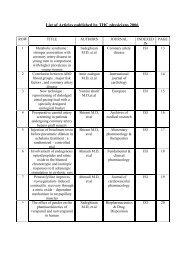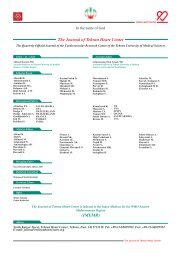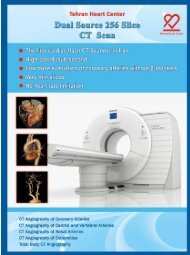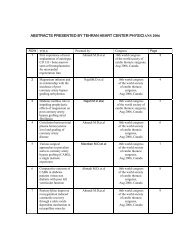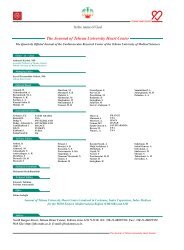THE JOURNAL OF TEHRAN UNIVERSITY HEART CENTER
THE JOURNAL OF TEHRAN UNIVERSITY HEART CENTER
THE JOURNAL OF TEHRAN UNIVERSITY HEART CENTER
You also want an ePaper? Increase the reach of your titles
YUMPU automatically turns print PDFs into web optimized ePapers that Google loves.
The Journal of Tehran University Heart Center<br />
atrium (RA) enlargement, and finally, severe low pressure<br />
TR due to the flail anterior leaflet of the tricuspid valve.<br />
Transesophageal echocardiography (TEE) was conducted<br />
as a complementary study and confirmed the flail leaflet<br />
secondary to the ruptured chordae. The patient was, therefore,<br />
scheduled for tricuspid valve repair.<br />
The operation was performed through median sternotomy.<br />
Following the institution of cardiopulmonary bypass (CPB),<br />
the heart was arrested via cardioplegia and the RA was<br />
explored: there was chordae rupture of the anterior leaflet.<br />
The rupture was repaired by first constructing two near<br />
chordae with 5/0 Gortex suture and then placing edge-toedge<br />
stitches on the edge of the three leaflets. Additionally,<br />
ring annuloplasty using a Carpenter (31mm) was performed.<br />
Postoperative TEE demonstrated mild to moderate TR and<br />
no significant tricuspid valve stenosis (TS) (tricuspid valve<br />
mean gradient = 2.5 mm Hg). The patient’s postoperative<br />
course was uneventful.<br />
Case # 2<br />
A 53-year-old man was referred to our hospital because of<br />
exertional dyspnea. One year previously, he had sustained<br />
multiple traumas in a bus accident. The accident left him in<br />
a deep coma for 17 days, after which he suffered a stroke,<br />
right hemi-paresis, and aphasia due to infarction in the left<br />
temporal lobe. Also, he had fractures in the left femoral<br />
bone, left tibia bone, right hand, and two ribs on the superior<br />
right side. At the time, no cardiac symptoms were detected<br />
but the patient was subjected to splenectomy.<br />
On admission, the electrocardiogram showed sinus rhythm,<br />
right bundle branch block with left-axis deviation. TTE<br />
revealed a normal LV size with mildly reduced LV systolic<br />
function, abnormal septal motion due to the RV volume<br />
overload, severe RV and RA enlargement with mild RV<br />
systolic dysfunction, and flail anterior tricuspid valve leaflet<br />
with severe low pressure TR. In addition, a large, mobile<br />
filamentous mass was detected on the tip of the flail leaflet, in<br />
favor of ruptured chordae. These findings were all confirmed<br />
by preoperative TEE, which also demonstrated an aneurismal<br />
inter-atrial septum with a small secondary type of atrial septal<br />
defect (ASD). Cardiac catheterization showed a small left-toright<br />
shunt with no evidence of coronary artery disease.<br />
Intraoperatively, the chest was explored via median<br />
sternotomy. CPB was instituted, the heart was arrested by<br />
cardioplegia, and the RA was explored. The anterior papillary<br />
muscle was ruptured, resulting in the prolapse of the anterior<br />
tricuspid leaflet. The De Vega technique was applied to the<br />
tricuspid annulus. Pledgeted 4/0 Prolene suture was used for<br />
the reconstruction of the anterior tricuspid valve papillary<br />
muscle to scar tissue in the base of the papillary muscle.<br />
Linear repair was thereafter performed for the closure of<br />
the ASD. Saline test was carried out next and the result was<br />
Kyomars Abbasi et al.<br />
so optimal that it obviated the need for TEE. Postoperative<br />
TTE revealed mild RV enlargement with mild systolic<br />
dysfunction. Doppler and contras study showed mild TR and<br />
no residual shunt flow.<br />
The patient made an uneventful recovery. One year after<br />
surgery now, the patient is well and asymptomatic with<br />
trivial TR on echocardiography.<br />
Discussion<br />
Traumatic TR is a rare sequela in the wake of blunt thoracic<br />
trauma. The most likely cause is compression, decompression,<br />
or deceleration of the thorax. These mechanisms give rise to<br />
intraventricular pressure peaks, which in combination with a<br />
closed valve and the systolic pressure in the RV most often<br />
affect the chordae tendineae and the papillary muscles. 1<br />
TR frequently goes undiagnosed at blunt chest trauma<br />
because of its asymptomatic nature; sometimes several<br />
or even more than ten years elapse before a diagnosis is<br />
made. 7-10 Nevertheless, severe TR eventually leads to right<br />
ventricular dilatation and progressive right heart failure,<br />
even if it is associated with no pulmonary hypertension. 6 The<br />
clinical course of TR following blunt chest trauma varies<br />
largely. Little is known about the clinical course of isolated<br />
ruptured chordae tendineae. Indeed, the only detailed case to<br />
have been reported thus far is that by Kleikamp et al., whose<br />
patient developed TR due to ruptured chordae tendineae of<br />
the anterior leaflet seven years after a blunt chest trauma,<br />
which was surgically corrected. 1 It is deserving of note<br />
that the rupture of the chordae tendineae is believed to be<br />
the consequence of an acute increase in the RV pressure<br />
associated with a closed tricuspid valve. 11<br />
Conclusions<br />
The two cases presented herein demonstrate that the<br />
rupture of the chordae tendineae of the tricuspid valve could<br />
be another cause of TR following blunt chest trauma. This<br />
is, however, a condition that can be repaired surgically<br />
without the need for valve replacement. Advances in<br />
echocardiography have enabled earlier diagnosis and ergo<br />
more effective treatment.<br />
We recommend that physicians working at emergency<br />
departments be on the alert for this potential complication<br />
of non-penetrating chest trauma and subject all patients<br />
admitted to the emergency department due to blunt chest<br />
trauma to TTE or TEE for accurate diagnosis.<br />
References<br />
1. Kleikamp G, Schnepper U, Körtke H, Breymann T, Körfer R.<br />
186



